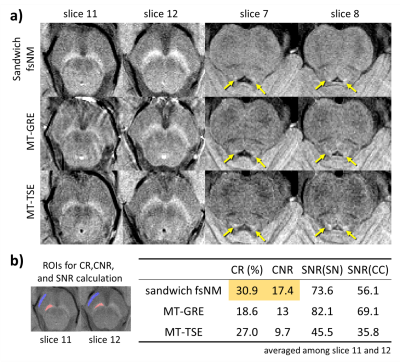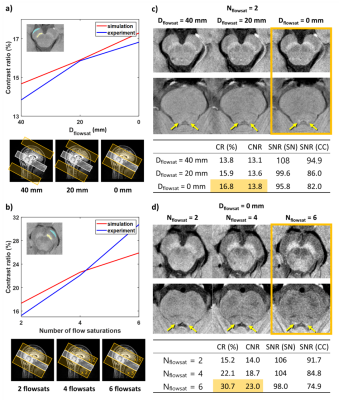Sooyeon Ji1, Eun-Jung Choi1, Eung Yeop Kim2, Dong Hoon Shin3, Hyeong-Geol Shin1, and Jongho Lee1
1Department of Electrical and Computer Engineering, Seoul National University, Seoul, Korea, Republic of, 2Department of Radiology, Gachon University Gil Medical Center, Incheon, Korea, Republic of, 3Department of Neurology, Gachon University Gil Medical Center, Incheon, Korea, Republic of
1Department of Electrical and Computer Engineering, Seoul National University, Seoul, Korea, Republic of, 2Department of Radiology, Gachon University Gil Medical Center, Incheon, Korea, Republic of, 3Department of Neurology, Gachon University Gil Medical Center, Incheon, Korea, Republic of
A 3D neuromelanin-sensitive imaging
protocol is developed using a GRE sequence with multiple flow saturation pulses
for magnetization transfer weighting. The proposed protocol displays higher
neuromelanin contrast compared to conventional methods.

Figure 5. Comparison of the images acquired with the
proposed protocol, MT-GRE, and MT-TSE. When calculated for the ROIs in b), the
contrast of the sandwich-fsNM is superior to both MT-GRE and MT-TSE imaging in
terms of CR and CNR. SNR of sandwich-fsNM is lower than MT-GRE but higher than MT-TSE.
MT-GRE images suffer from flow artifacts.

Figure 4. Simulated and experimental CR
between SN and CC with respect to a) Dflowsat and b) number of FSs (Nflowsat). The CR increases as Dflowsat
decreases and as Nflowsat increases, both in simulations
and experiments. The effect size of decreasing Dflowsat is
relatively smaller than that of increasing Nflowsat. c) In the experimental data, CNR
shows similar trends to CR whereas SNR decreases as Dflowsat
decreases and as d) Nflowsat increases.